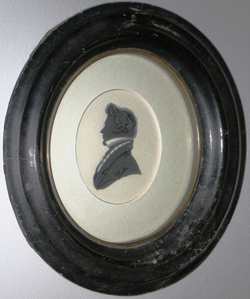 Davidson, William (1805 - 1837)
Davidson, William (1805 - 1837)
Born in 1805 in Northumberland, UK; died 9 July 1837 and buried at St David's Burial Ground, Hobart, Tasmania.
Prior to emigrating to Van Diemen's Land was head gardener in the estate of Robert Walker at Benwell. Now a suburb of Newcastle Upon Tyne, UK.
William arrived in Hobart on board the "Albion" on 31 December 1827. Although, on this occasion his stay was brief, he was able to arrange to meet with the Lieutenant Governor Arthur - no mean achievement for a gardener at a time when Arthur was often criticised for being remote from ordinary settlers.
At the end of January 1828 Davidson travelled to Sydney, but not liking the place, returned to Van Diemen's Land, this time to Port Dalrymple, arriving on 10 June 1828 by the ship "Industry".
On his arrival in Launceston, Davidson first lodged with John Smith at his estate, "Marchington".
Soon after on 16 June 1828, Davidson wrote to the Colonal Secretary:
"On my arrival in Van Diemen's Land per "Albion" in January last I had an interview with His Excellency the Lieutenant Governor and His Excellency intimated that the Government was in want of a person competent to take the management of the Botanical and Horticultural Gardens at Hobart Town."
Having received no reply to his 16 June 1828 application, on 8 September 1828 Davidson applied for a grant of land in the immediate vicinity of Launceston.
In the letter accompanying his application Davidson state that:
"I am by profession a Botanist, Nurseryman and Gardener and that I am possessed of capital to the amount of 500 Sterling - that I have upwards of 2000 Vines in a state of great forwardness, with various other descriptions of superior Fruit Trees, as well as every variety of Garden seeds and roots from the first Nurseries in England and a complete supply of Garden Utensils and Implements of every kind."
On 23 October 1828 a Mr Abbott wrote to the Colonial Secretary:
"Mr Davidson is a Northumberland man age 24, unmarried, he bears a respectable character here, and his appearance is much in his favour.... Since he arrived at this place he has planted about three hundred trees of different sorts besides upwards of two hundred grapevines and cuttings in the gardens and grounds of Messrs Smith and Williatt; many new and valuable plants ....
He has no objection to take the direction and charge of the Government Domain and Gardens at Hobart Town on condition of receiving a salary of one hundred pounds with a ration and a house to live in. He further expects the privilege to sell for his own use such plants and shrubs as he may raise and not wanted by the Government. In going to Hobart Town he would, of course be obliged to make sacrifices on account of the trees, shrubs etc he must necessarily leave behind".
On 18 November 1828 William Davidson was appointed by Governor Arthur as the 1st Superintendent of the Government and Domain Gardens (later known as Royal Tasmanian Botanical Gardens).
Governor Arthur was elated to get a trained and competent man to take charge of the Garden. He was to be paid a salary of one hundred pounds per annum, rations and a house in the Government Garden. Davidson proved to be the right man for the job, developing the gardens rapidly.
By 1830, there was an enclosed area of 13 acres. Twelve gardeners and 12 convicts were needed to cultivate the gardens and clear the Domain.
The expansion of the Gardens did not proceed without criticism. In 1831, the "Colonial Times" complained of the excessive number of convicts employed there. The editor suggested that the Gardens benefited only two or three of the colony's "leading stars" and wondered what was done with all the cabbages and cauliflowers!
The cultivation of native plants was not neglected. He had over 130 species growing which had been gathered from the slopes and summit of Mount Wellington. Seed was also sent to the Royal Belfast Institution and to the Horticultural Gardens at Hammersmith, London, where they were reported as thriving luxuriantly in 1832.
The Gardens became so popular that by December 1832, Governor Arthur directed that they be closed on Sundays. This was because of "the extreme inconvenience and injury which arises from the great number of persons who resort there on the Sundays", accoring to the Superintendent.
William Davidson married Elizabeth Nesbett listed as a cabin passenger on the "Triton" from Leith, Scotland which arrived in Hobart on 9 June 1829. Together they had 4 children.
In 1834 Davidson was dismissed by Colonel Arthur for the disposal of four cabages, four turnips and four cauliflowers from the government gardens without Arthur's authorosation.
William Davidson died suddenly on 9 July 1837 at 33 years of age. He is buried at St David's Burial Ground. Cause of death is still unknown! One could speculate that he died of a "broken heart" after his dismissal from the Government Gardens in 1834.
During his tenure, he was responsible for the creation of a large greenhouse, the importation of honeybee hives and the establishment of a thriving kitchen garden as well as many displays of indigenous and exotic plants. Davidson left a legacy of plant collections including specimens he had gathered on excursions along the edge of Hobart's River Derwent and on kunanyi/Mount Wellington.
Source: Extracted from:
https://gardens.tas.gov.au/about/heritage/superintendent%E2%80%99s-cottage-(1829)
https://davidsonfamilyarchives.blogspot.com/2013/01/william-davidson-botanist.html
Aitken & Looker (eds.) 'The Oxford Companion to Australian Gardens', 2002, Melbourne, pp.177-178
Portrait Photo: https://davidsonfamilyarchives.blogspot.com/2013/01/william-davidson-botanist.html


 Davidson, William (1805 - 1837)
Davidson, William (1805 - 1837)